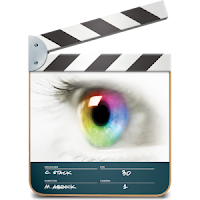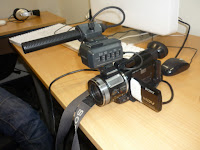
In this scene Jayde has given Paige the bag of money but there is some money missing so he is becoming more concerned to what is going to happen next. This is a close up shot as the camera is focused on Jayde's face and shoulders showing his emotion of worry and anxiety.
In this scene Jayde is on his way to Paige's office where he's meeting her to give her the money. This is a birds eye view camera shot as we can see Jayde from directly above. This camera shot makes it look like someone is spying on him whilst also showing a different spatial perspective of the setting.

In this scene Jayde is trying to escape from Paige's office but he finds himself trapped as the door is locked. This is a over the shoulder shot as we are looking from behind Paige's shoulder facing Jayde. This type of shot is used for discussions between two people.
MY MISTAKE:

When filming my preliminary task i made a big mistake, as you can see Jayde was wearing grey tracksuit bottoms in one shot and dark denim jeans in another shot. I had to reshoot some shots but i had totally forgotten what Jayde was wearing for the original shots so when I placed the clips together i noticed his outfit had changed. This is the key rule you have to think about when filming as everything needs to be the same. When filming my two minute title sequence, i remembered to always keep the mise-en-scene the same, for example - if Jayde was holding a bag, I'd make sure he was also holding it in the same hand.
HERE ARE THE CAMERA TECHNIQUES I LEARNED:
 I had to learn about the 180° degree rule before i began filming. The 180 dregree rule is a standard guidline in film making which states two characters should always have the same left/right relationship to each other. If the camera passes over the imaginary line connecting the two characters, this means the 180° degree rule has been broken.
I had to learn about the 180° degree rule before i began filming. The 180 dregree rule is a standard guidline in film making which states two characters should always have the same left/right relationship to each other. If the camera passes over the imaginary line connecting the two characters, this means the 180° degree rule has been broken.When filming my two minute title sequence, i used various shots which i never used in my preliminary task. These shots consisted of:

In this scene, Jayde is running behind Thomas as they are trying to run from the police. This is a point of view (POV) camera shot as we can see a view from Jayde's perspective. This type of shot makes the audience think and feel like the character as we are in their shoes. This is a good technique to draw the audience into the scene.
In this shot Jayde and Thomas have stopped for a break whilst engaging in a conversation shouting at one another. This is a two shot. This type of shot usually establishes some sort of relationship between two characters letting the audience know who they are in relation to each other. As we can see Thomas is Jayde's big brother and he's trying to look of for him making sure he gets away from the police.
In this shot Jayde is reminiscing have flashbacks of the day when he and his brother Thomas were running from the police. This is an extreme close up camera shot as we can see Jayde's eyes in depth. This shot was used so the audience could establish his emotions and feel sympathy for him. This type of shot is a very effective way of drawing an audience into a character.



































